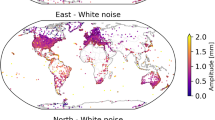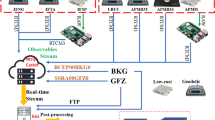Abstract
A modified BDS Klobuchar ionospheric time-delay correction model (MBDK) is proposed for single-frequency users of the BeiDou Navigation Satellite System (BDS). Instead of using a constant night-time delay (5 ns) in the broadcast BDS Klobuchar model (BDSK), the night-time delay is considered a parameter and estimated hourly in our new model. To keep the same number of eight ionospheric coefficients transmitted in the navigation message, the fourth legacy coefficient of the period term is replaced by the new night-time parameter. The fitted legacy BDS Klobuchar model (BDFK) that is re-estimated using the same input ionospheric total electron content (TEC) data for the MBDK is also included for comparison. Tests from day of year 155 to 366 in 2020 demonstrate that the proposed MBDK model performs better than the broadcast BDSK model and the fitted BDFK model in comparison with the global ionospheric maps provided by the International GNSS Service (IGS). The root mean square values of the BDSK and BDFK are 5.2 and 4.3 TEC unit (TECU), respectively, while it is 3.7 TECU for the MBDK, showing improvements of 29% and 14%, respectively, on the global scale. When only considering the northern hemisphere, the improvements are increased significantly to 47% and 33%, mainly because of the use of only northern hemisphere ionospheric data for the generation of the MBDK model. In the northern hemisphere, the BDSK, BDFK and MBDK models can correct 64%, 71% and 78% of the ionospheric time delay, respectively. Twenty IGS stations are selected to analyze the positioning error induced by the residual ionospheric delay after using the MBDK. The average ionospheric errors of the BDSK, BDFK and MBDK are 5.1, 4.4 and 3.9 TECU, respectively. As expected, the MBDK exhibits the best performance, which outperforms the BDSK and BDFK by 22% and 11%, respectively. It should be mentioned that the performance of the BDSK, BDFK and MBDK in the southern hemisphere is worse than that in the northern hemisphere due to the simple “symmetrical strategy” used. We recommend adding ionospheric input data in the southern hemisphere to improve the precision of the BDS Klobuchar model in this hemisphere.














Similar content being viewed by others
Data availability
The broadcast ionospheric coefficients of the BDS Klobuchar model are available from the first author (zhangqiang@whu.edu.cn) or the corresponding author (zhigang.hu@whu.edu.cn) on request.
References
CSNO (2012) BeiDou navigation satellite system signal in space interface control document—open service signal B1I (Version 1.0). China Satellite Navigation Office, Dec 2012
CSNO (2018) BeiDou navigation satellite system signal in space interface control document—open service signal B3I (Version 1.0). China Satellite Navigation Office, Feb 2018
Feltens J (2003) The activities of the ionosphere working group of the international GPS service (IGS). GPS Solutions 7(1):41–46
Hernández-Pajares M, Juan JM, Sanz J, Orus R, Garcia-Rigo A, Feltens J, Komjathy A, Schaer SC, Krankowski A (2009) The IGS VTEC maps: a reliable source of ionospheric information since 1998. J Geodesy 83(3–4):263–275
ICD-GPS-200 (1983) Navistar GPS Space Segment/Navigation User Interfaces (Initial release). GPS Joint Program Office, Jan 1983
Klobuchar JA (1975) A first-order, worldwide, ionospheric, time-delay algorithm. Air Force Cambridge Research Laboratories, Massachusetts
Klobuchar JA (1987) Ionospheric time delay algorithm for single frequency GPS users. IEEE Trans Aerosp Electron Syst 23(3):325–331
Klobuchar JA (1991) Ionospheric effects on GPS. GPS World 4(2):48–51
Orús R, Hernández-Pajares M, Juan JM, Sanz J, Garcıa-Fernández M (2002) Performance of different TEC models to provide GPS ionospheric corrections. J Atmos Solar Terr Phys 64(18):2055–2062
Schaer S (1999) Mapping and predicting the earth’s ionosphere using the global positioning system. Ph.d., Dissertation. University of Berne
Wang N, Yuan Y, Li Z, Huo X (2016) Improvement of Klobuchar model for GNSS single-frequency ionospheric delay corrections. Adv Space Res 57(7):1555–1569
Wang N, Yuan Y, Li Z, Li Y, Huo X, Li M (2017) An examination of the Galileo NeQuick model: comparison with GPS and JASON TEC. GPS Solut 21(2):605–615
Wang N, Li Z, Li M, Yuan Y, Huo X (2018) GPS, BDS and Galileo ionospheric correction models: an evaluation in range delay and position domain. J Atmos Solar Terr Phys 170:83–91
Wang N, Li Z, Huo X, Li M, Yuan Y, Yuan C (2019a) Refinement of global ionospheric coefficients for GNSS applications: methodology and results. Adv Space Res 63(1):343–358
Wang N, Li Z, Yuan Y, Li M, Huo X, Yuan C (2019b) Ionospheric correction using GPS Klobuchar coefficients with an empirical nighttime delay model. Adv Space Res 63(2):886–896
Wu X, Hu X, Wang G, Zhong H, Tang C (2013) Evaluation of COMPASS ionospheric model in GNSS positioning. Adv Space Res 51(6):959–968
Yuan Y, Huo X, Ou J, Zhang K, Chai Y, Wen D, Grenfell R (2008) Refining the Klobuchar ionospheric coefficients based on GPS observations. IEEE Trans Aerosp Electron Syst 44(4):1498–1510
Yuan Y, Wang N, Li Z, Huo X (2019) The BeiDou global broadcast ionospheric delay correction model (BDGIM) and its preliminary performance evaluation results. Navigation 66(1):55–69
Zhang Q, Zhao Q (2018) Global ionosphere mapping and differential code bias estimation during low and high solar activity periods with GIMAS software. Remote Sensing 10(5):705
Acknowledgements
The research is partially supported by China Postdoctoral Science Foundation (Grant No. 2019M662715), the Key Laboratory of Geospace Environment and Geodesy, Ministry of Education, Wuhan University (Grant No. 19-02-09), the Fundamental Research Funds for the Central Universities (Grant No. 2042021kf0061), the National Natural Science Foundation of China (Grant No. 42030109) and LIESMARS Special Research Funding. The authors would like to acknowledge the IGS Global Data Center CDDIS for providing the GNSS data and IGS GIM products.
Author information
Authors and Affiliations
Corresponding author
Additional information
Publisher's Note
Springer Nature remains neutral with regard to jurisdictional claims in published maps and institutional affiliations.
Rights and permissions
About this article
Cite this article
Zhang, Q., Liu, Z., Hu, Z. et al. A modified BDS Klobuchar model considering hourly estimated night-time delays. GPS Solut 26, 49 (2022). https://doi.org/10.1007/s10291-022-01236-0
Received:
Accepted:
Published:
DOI: https://doi.org/10.1007/s10291-022-01236-0




